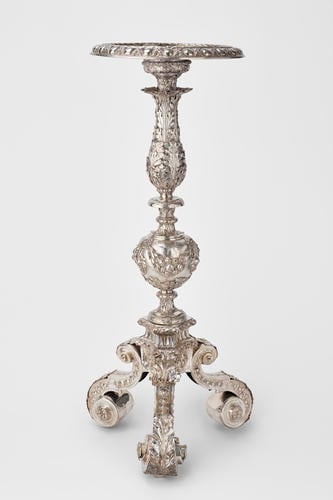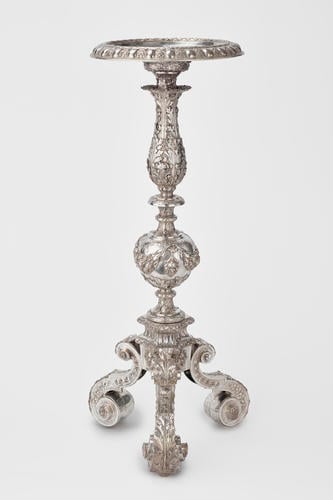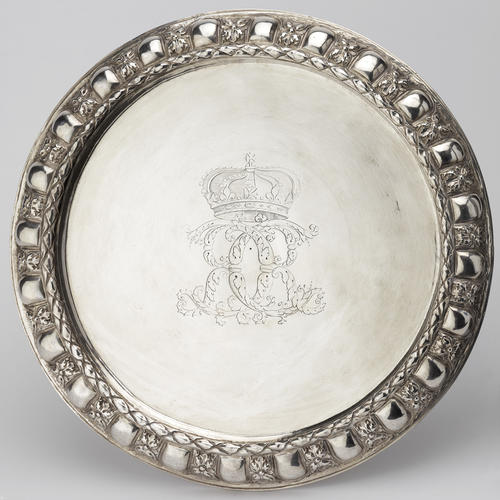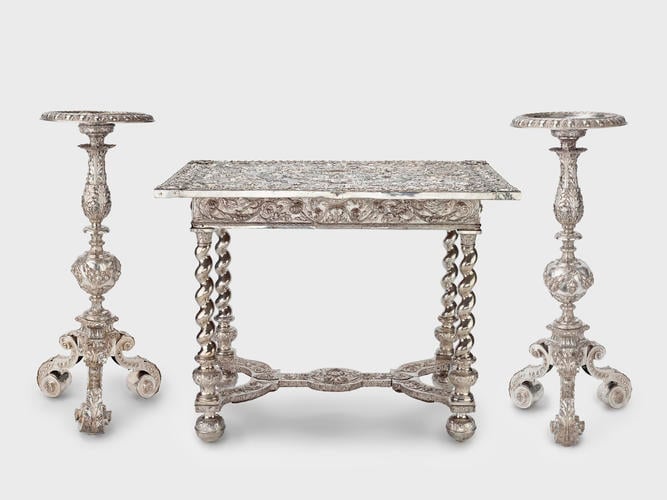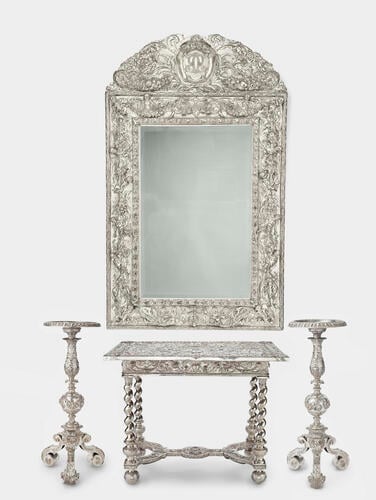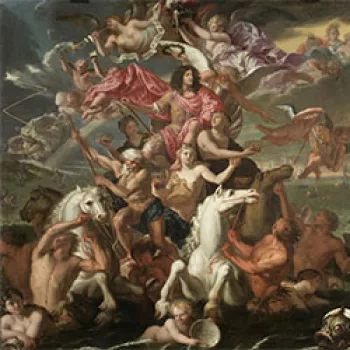Silver candelabra stands c. 1670
Chased and engraved silver | 101.0 x 45.0 x 39.5 cm (whole object) | RCIN 35298
-
A pair of silver candlestands. Each with the top engraved with crowned interlaced 'C's (for Charles II). Stem of baluster shape, chased with foliage, garlands of fruit, etc, springing from triangular hub. On three foliate S-scroll shaped legs.
This pair of candelabra stands, both marked with the cipher of Charles II, are testimony to the extravagant vogue for silver furniture that reached its height in England during the decades following the Restoration. From the mid-seventeenth century, European rulers had begun to commission silver furnishings on a grand scale, the most famous being Louis XIV's solid silver furniture at Versailles made by the craftsmen of the Manufactures des Gobelins and the Galeries du Louvres. Such spectacular and obviously costly furnishings played an important role in the creation of magnificence and the representation of power. In the state apartments, the combination of a mirror, table and stands was a static arrangement that was commonly placed against the wall in between two windows. At night, light from candelabra placed on stands would have been reflected into the room by the mirror, while the silver surfaces sparkled and glowed, creating a magnificent visual effect.
Bills for silver furnishings purchased by Charles II have not survived, making it impossible to know for certain when or by whom the mirror, table and stands were made. Only the stands are marked with a gouge assay mark, which might indicate a continental origin. Certainly, the design of all three pieces reflects the influence of Parisian silversmiths such as Claude Ballin and Nicholas de Launay, who supplied silver furniture for Louis XIV at Versailles. On the other hand, there were silversmiths working in England who were capable of such sophisticated workmanship. One possible candidate is John Cooqus (or Cockus), who was appointed 'silversmith in ordinary to his Matie for chastwork within his Maties bedchamber and closet and also the bedchamber of the Queen' in 1661.Cooqus, who was Dutch, is best known as one of the makers of Nell Gwyn's extravagant bed that featured a silver headboard decorated with reliefs of Charles II's head, crowns, cupids and eagles. His other documented commissions include a 12-branch silver chandelier for the queen that cost the enormous sum of £586 19s and a large quantity of chapel plate for Whitehall and Windsor.
The first official reference to silver furniture appears in 1681 when the Jewel House received an order to boil (clean) the silver frames of looking glasses in the queen's state bedchamber at Whitehall. By the time of his death in 1685, Charles II's state bedchamber at Whitehall was also furnished with 'a large silver Looking Glasse, and a large Silver Table with a paire of Large silver stands, a large paire of silver ffire Irons, and a paire of Doggs'. The mirror, table and stands were later given to Mary of Modena for use in her state bedchamber at Whitehall where they appear to have remained until at least 1688. Warrants for cleaning prior to the birth of James II's son in June of that year, record that by this time the king and queen had an impressive quantity of silver furniture including six tables, five mirror frames and ten stands, some of which had almost certainly belonged to Charles II.
Text adapted from Charles II: Art & Power (2017).
On his accession in 1760 George III inherited three late seventeenth-century suites of silver tables, mirrors and stands. They had been displayed in the State rooms in Windsor Castle since the reign of Queen Anne and in the early years of the King's reign they were regularly cleaned and repaired. A further set was in the collection of Frederick, Prince of Wales, at Leicester House in the 1740s. These were the remnants of far larger suites of silver furnishings, which had been displayed throughout the royal palaces during the reigns of the later Stuarts. The popularity of silver furnishings had however diminished in the first half of the eighteenth century and in February 1764 'three silver tables and six stands', together with numerous old sconces, chandeliers and firedogs 'which are not English Standard', were 'Delivered to be melted . . . to be reduced into English Sterling to complete his Majesty's Gift of 8000oz of old Plate to the Duke of Gloucester' - part of a generous gift for the King's brother, Prince William, Duke of Gloucester.
Thereafter the three sets disappear from the Jewel House records. However in February 1805 an account of 'their Majesties' Fete at Windsor Castle' noted 'the novel and grand appearance of four silver tables, between each window [in the Queen's Gallery]. The magnificent effect of the tables was considerably heightened by four most elegant pier glasses over each with silver frames'. In addition five silver chandeliers were hung in the Queen's Gallery and the Queen's Drawing Room next door.
This magnificent arrangement was recorded in a view of the Queen's Gallery in 1817. It would therefore appear that elements of at least two of the sets of silver tables, mirrors and stands were spared the melting pot in 1764. One composite surviving set includes two stands, a table and a mirror decorated with the cipher of Charles II. The stands are marked with an assay scrape, which might indicate a continental, perhaps Dutch origin; the design, however, is of markedly French inspiration and reflects the influence of Parisian silversmiths such as Claude T Ballin and Nicolas de Launay, who supplied silver furniture for Louis XIV at Versailles in the early 1680s. It would therefore appear that by 1805 George III had had a change of heart, and that these examples of high baroque furnishings were now deemed suitable for his newly refurbished apartments at Windsor Castle.
One stand marked with an assay scrape; one tripod base an electrotype replacement
Catalogue entry adapted from George III & Queen Charlotte: Patronage, Collecting and Court Taste, London, 2004Provenance
Probably acquired by Charles II.
-
Creator(s)
Acquirer(s)
-
Medium and techniques
Chased and engraved silver
Measurements
101.0 x 45.0 x 39.5 cm (whole object)
Category
Other number(s)
Laking FR : Laking, G.F., 1905. The Furniture of Windsor Castle, London – Laking FR p21,pl.6




